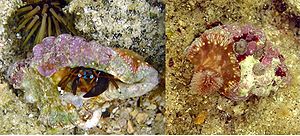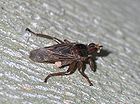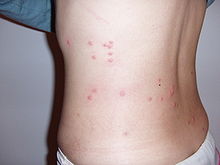- Symbiosis
-
"Symbiology" redirects here. For use of things that represent other things by association, resemblance, or convention, see Symbology.This article is about the biological phenomenon. For other uses, see Symbiosis (disambiguation). For the Marvel character, see Symbiote (comics).
 In a symbiotic mutualism, the clownfish feeds on small invertebrates which otherwise potentially could harm the sea anemone, and the fecal matter from the clownfish provides nutrients to the sea anemone. The clownfish is additionally protected from predators by the anemone's stinging cells, to which the clownfish is immune.
In a symbiotic mutualism, the clownfish feeds on small invertebrates which otherwise potentially could harm the sea anemone, and the fecal matter from the clownfish provides nutrients to the sea anemone. The clownfish is additionally protected from predators by the anemone's stinging cells, to which the clownfish is immune.
Symbiosis (from Ancient Greek sýn "with" and bíōsis "living")[1] is close and often long-term interaction between different biological species. In 1877 Bennett used the word symbiosis (which previously had been used of people living together in community) to describe the mutualistic relationship in lichens.[2] In 1879, by the German mycologist Heinrich Anton de Bary, defined it as "the living together of unlike organisms."[3][4]
The definition of symbiosis is controversial among scientists. Some believe symbiosis should only refer to persistent mutualisms, while others believe it should apply to all types of persistent biological interactions (i.e. mutualistic, commensalistic, or parasitic).[5]
Some symbiotic relationships are obligate, meaning that both symbionts entirely depend on each other for survival. For example, many lichens consist of fungal and photosynthetic symbionts that cannot live on their own.[3][6][7][8] Others are facultative, meaning that they can, but do not have to live with the other organism.
Symbiotic relationships include those associations in which one organism lives on another (ectosymbiosis, such as mistletoe), or where one partner lives inside the other (endosymbiosis, such as lactobacilli and other bacteria in humans or zooxanthelles in corals).[9][10]
Contents
Physical interaction
Endosymbiosis is any symbiotic relationship in which one symbiont lives within the tissues of the other, either in the intracellular space or extracellularly.[10][11] Examples are rhizobia, nitrogen-fixing bacteria that live in root nodules on legume roots; actinomycete nitrogen-fixing bacteria called Frankia, which live in alder tree root nodules; single-celled algae inside reef-building corals; and bacterial endosymbionts that provide essential nutrients to about 10%–15% of insects.
Ectosymbiosis, also referred to as exosymbiosis, is any symbiotic relationship in which the symbiont lives on the body surface of the host, including the inner surface of the digestive tract or the ducts of exocrine glands.[10][12] Examples of this include ectoparasites such as lice, commensal ectosymbionts such as the barnacles that attach themselves to the jaw of baleen whales, and mutualist ectosymbionts such as cleaner fish.
Mutualism
Main article: Mutualism (biology) Hermit crab, Calcinus laevimanus, with sea anemone.
Hermit crab, Calcinus laevimanus, with sea anemone.
Mutualism is any relationship between individuals of different species where both individuals derive a benefit.[13] Generally, only lifelong interactions involving close physical and biochemical contact can properly be considered symbiotic. Mutualistic relationships may be either obligate for both species, obligate for one but facultative for the other, or facultative for both. Many biologists restrict the definition of symbiosis to close mutualist relationships.
A large percentage of herbivores have mutualistic gut fauna that help them digest plant matter, which is more difficult to digest than animal prey.[9] Coral reefs are the result of mutualisms between coral organisms and various types of algae that live inside them.[14] Most land plants and land ecosystems rely on mutualisms between the plants, which fix carbon from the air, and mycorrhyzal fungi, which help in extracting minerals from the ground.[15]
An example of mutual symbiosis is the relationship between the ocellaris clownfish that dwell among the tentacles of Ritteri sea anemones. The territorial fish protects the anemone from anemone-eating fish, and in turn the stinging tentacles of the anemone protect the clownfish from its predators. A special mucus on the clownfish protects it from the stinging tentacles.[16]
Another example is the goby fish, which sometimes lives together with a shrimp. The shrimp digs and cleans up a burrow in the sand in which both the shrimp and the goby fish live. The shrimp is almost blind, leaving it vulnerable to predators when above ground. In case of danger the goby fish touches the shrimp with its tail to warn it. When that happens both the shrimp and goby fish quickly retreat into the burrow.[17]
One of the most spectacular examples of obligate mutualism is between the siboglinid tube worms and symbiotic bacteria that live at hydrothermal vents and cold seeps. The worm has no digestive tract and is wholly reliant on its internal symbionts for nutrition. The bacteria oxidize either hydrogen sulfide or methane which the host supplies to them. These worms were discovered in the late 1980s at the hydrothermal vents near the Galapagos Islands and have since been found at deep-sea hydrothermal vents and cold seeps in all of the world's oceans.[18]
There are also many types of tropical and sub-tropical ants that have evolved very complex relationships with certain tree species.[19]
Commensalism
 Phoretic mites on a fly (Pseudolynchia canariensis).
Phoretic mites on a fly (Pseudolynchia canariensis). Main article: Commensalism
Main article: CommensalismCommensalism describes a relationship between two living organisms where one benefits and the other is not significantly harmed or helped. It is derived from the English word commensal used of human social interaction. The word derives from the medieval Latin word, formed from com- and mensa, meaning "sharing a table".[13][20]
Commensal relationships may involve one organism using another for transportation (phoresy) or for housing (inquilinism), or it may also involve one organism using something another created, after its death (metabiosis). Examples of metabiosis are hermit crabs using gastropod shells to protect their bodies and spiders building their webs on plants.
Parasitism
Flea bites on a human is an example of parasitism. Main article: Parasitism
Main article: ParasitismA parasitic relationship is one in which one member of the association benefits while the other is harmed.[21] Parasitic symbioses take many forms, from endoparasites that live within the host's body to ectoparasites that live on its surface. In addition, parasites may be necrotrophic, which is to say they kill their host, or biotrophic, meaning they rely on their host's surviving. Biotrophic parasitism is an extremely successful mode of life. Depending on the definition used, as many as half of all animals have at least one parasitic phase in their life cycles, and it is also frequent in plants and fungi. Moreover, almost all free-living animals are host to one or more parasite taxa. An example of a biotrophic relationship would be a tick feeding on the blood of its host.
Amensalism
Amensalism is the type of symbiotic relationship that exists where one species is inhibited or completely obliterated and one is unaffected. This type of symbiosis is relatively uncommon in rudimentary reference texts, but is omnipresent in the natural world. An example is a sapling growing under the shadow of a mature tree. The mature tree can begin to rob the sapling of necessary sunlight and, if the mature tree is very large, it can take up rainwater and deplete soil nutrients. Throughout the process the mature tree is unaffected. Indeed, if the sapling dies, the mature tree gains nutrients from the decaying sapling. Note that these nutrients become available because of the sapling's decomposition, rather than from the living sapling, which would be a case of parasitism.
Symbiosis and evolution
While historically, symbiosis has received less attention than other interactions such as predation or competition,[22] it is increasingly recognized as an important selective force behind evolution,[9][23] with many species having a long history of interdependent co-evolution.[24] In fact, the evolution of all eukaryotes (plants, animals, fungi, and protists) is believed under the endosymbiotic theory to have resulted from a symbiosis between various sorts of bacteria.[9][25][26]
Vascular plants
Up to 80% of vascular plants worldwide form symbiotic relationships with fungi, for example, in arbuscular mycorrhiza.[27]
Symbiogenesis
The biologist Lynn Margulis, famous for her work on endosymbiosis, contends that symbiosis is a major driving force behind evolution. She considers Darwin's notion of evolution, driven by competition, to be incomplete and claims that evolution is strongly based on co-operation, interaction, and mutual dependence among organisms. According to Margulis and Dorion Sagan, "Life did not take over the globe by combat, but by networking."[28]
Co-evolution
Symbiosis played a major role in the co-evolution of flowering plants and the animals that pollinate them. Many plants that are pollinated by insects, bats, or birds have highly specialized flowers modified to promote pollination by a specific pollinator that is also correspondingly adapted. The first flowering plants in the fossil record had relatively simple flowers. Adaptive speciation quickly gave rise to many diverse groups of plants, and, at the same time, corresponding speciation occurred in certain insect groups. Some groups of plants developed nectar and large sticky pollen, while insects evolved more specialized morphologies to access and collect these rich food sources. In some taxa of plants and insects the relationship has become dependent,[29] where the plant species can only be pollinated by one species of insect.[30]
Notes
- ^ σύν, βίωσις. Liddell, Henry George; Scott, Robert; A Greek–English Lexicon at Perseus Project
- ^ "symbiosis". Oxford English Dictionary. Oxford University Press. 2nd ed. 1989.
- ^ a b Wilkinson 2001
- ^ Douglas 1994, p. 1
- ^ Douglas, Angela E. (2010), The symbiotic habit, New Jersey: Princeton University Press, pp. 5–12, ISBN 978-0-691-11341-8
- ^ Isaac 1992, p. 266
- ^ Saffo 1993
- ^ Douglas, Angela E. (2010), The symbiotic habit, New Jersey: Princeton University Press, p. 4, ISBN 978-0-691-11341-8
- ^ a b c d Moran 2006
- ^ a b c Ahmadjian & Paracer 2000, p. 12
- ^ Sapp 1994, p. 142
- ^ Nardon & Charles 2002
- ^ a b Ahmadjian & Paracer 2000, p. 6
- ^ Toller, Rowan & Knowlton 2001
- ^ Harrison 2005
- ^ Lee 2003
- ^ Facey, Helfman & Collette 1997
- ^ Cordes 2005
- ^ Piper, Ross (2007), Extraordinary Animals: An Encyclopedia of Curious and Unusual Animals, Greenwood Press.
- ^ Nair 2005
- ^ Ahmadjian & Paracer 2000, p. 7
- ^ Townsend, Begon & Harper 1996
- ^ Wernegreen 2004
- ^ Ahmadjian & Paracer 2000, pp. 3–4
- ^ Brinkman 2002
- ^ Golding & Gupta 1995
- ^ Schüßler, A. et al. (2001), "A new fungal phlyum, the Glomeromycota: phylogeny and evolution", Mycol. Res. 105 (12): 1416, http://journals.cambridge.org/action/displayAbstract?fromPage=online&aid=95091.
- ^ Sagan & Margulis 1986
- ^ Harrison 2002
- ^ Danforth & Ascher 1997
See also
- aposymbiotic
- aquaponics
- Cheating (biology)
- decompiculture
- list of symbiotic organisms
- list of symbiotic relationships
- multigenomic organism
- Symbiogenesis
- Symbiosis (chemical)
References
- Ahmadjian, Vernon; Paracer, Surindar (2000), Symbiosis: an introduction to biological associations, Oxford [Oxfordshire]: Oxford University Press, ISBN 0-195-11806-5
- Burgess, Jeremy (1994), Forum: What's in it for me, New Scientist, http://media.newscientist.com/article/mg14119115.200-forum-whats-in-it-for-me--jeremy-burgess-examines-therole-of-cooperation-within-natures-competitive-ways-.html
- Boucher, Douglas H (1988), The Biology of Mutualism: Ecology and Evolution, New York: Oxford University Press, ISBN 0195053923
- Cordes, E.E.; Arthur, M.A.; Shea, K.; Arvidson, R.S.; Fisher, C.R. (2005), "Modeling the mutualistic interactions between tubeworms and microbial consortia", PLoS Biol 3 (3): 1–10, doi:10.1371/journal.pbio.0030077, PMC 1044833, PMID 15736979, http://www.pubmedcentral.nih.gov/articlerender.fcgi?tool=pmcentrez&artid=1044833, retrieved 2007-09-23
- Brinkman, F.S.L.; Blanchard, J.L.; Cherkasov, A.; Av-gay, Y.; Brunham, R.C.; Fernandez, R.C.; Finlay, B.B.; Otto, S.P.; Ouellette, B.F.F.; Keeling, P.J.; Others, (2002), "Evidence That Plant-Like Genes in Chlamydia Species Reflect an Ancestral Relationship between Chlamydiaceae, Cyanobacteria, and the Chloroplast", Genome Research 12 (8): 1159–1167, doi:10.1101/gr.341802, PMC 186644, PMID 12176923, http://www.csa.com/partners/viewrecord.php?requester=gs&collection=ENV&recid=5449063, retrieved 2007-09-30
- Danforth, B.N.; Ascher, J. (1997), "Flowers and Insect Evolution", Science 283 (5399): 143, doi:10.1126/science.283.5399.143a, http://www.sciencemag.org/cgi/reprint/283/5399/143a.pdf, retrieved 2007-09-25
- Douglas, Angela (2010), The Symbiotic Habit, Princeton University Press, ISBN 0-19-854294-1
- Douglas, Angela (1994), Symbiotic interactions, Oxford [Oxfordshire]: Oxford University Press, ISBN 0-19-854294-1
- Facey, Douglas E.; Helfman, Gene S.; Collette, Bruce B. (1997), The diversity of fishes, Oxford: Blackwell Science, ISBN 0-86542-256-7
- Golding, RS; Gupta, RS (1995), "Protein-based phylogenies support a chimeric origin for the eukaryotic genome", Mol. Biol. Evol. 12 (1): 1–6, PMID 7877484
- Harrison, Rhett (2002), "Balanced mutual use (symbiosis)", Quarterly journal Biohistory 10 (2), https://www.brh.co.jp/en/experience/journal/32/ss_3.html, retrieved 2007-09-23
- Harrison, Maria J. (2005), "Signaling in the arbuscular mycorrhizal symbiosis", Annu. Rev. Microbiol. 59: 19–42, doi:10.1146/annurev.micro.58.030603.123749, PMID 16153162
- Lee, J. (2003), "Amphiprion percula" (On-line), Animal Diversity Web, http://animaldiversity.ummz.umich.edu/site/accounts/information/Amphiprion_percula.html, retrieved 2007-09-29
- Isaac, Susan (1992), Fungal-plant interactions, London: Chapman & Hall, ISBN 0-412-36470-0
- Isaak, Mark (2004), CB630: Evolution of obligate mutualism, TalkOrigins Archive, http://www.talkorigins.org/indexcc/CB/CB630.html, retrieved 2007-09-25
- Moran, N.A. (2006), "Symbiosis", Current Biology 16 (20): 866–871, doi:10.1016/j.cub.2006.09.019, PMID 17055966, http://linkinghub.elsevier.com/retrieve/pii/S0960982206022123, retrieved 2007-09-23
- Nardon, P.; Charles, H. (2002), "Morphological aspects of symbiosis", Symbiosis: Mechanisms and Systems. Dordercht/boson/London, Kluwer Academic Publishers 4: 15–44, doi:10.1007/0-306-48173-1_2
- Powell, Jerry (1992), "Interrelationships of yuccas and yucca moths", Trends in Ecology and Evolution 7 (1): 10–15, doi:10.1016/0169-5347(92)90191-D, PMID 21235936
- Nair, S. (2005), "Bacterial Associations: Antagonism to Symbiosis", in Ramaiah, N, Marine Microbiology: Facets & Opportunities;, National Institute of Oceanography, Goa, pp. 83–89, http://drs.nio.org/drs/handle/2264/74, retrieved 2007-10-12
- Roughgarden, J.; Gomulkiewicz; Holt; Thompson (1975), "Evolution of Marine Symbiosis--A Simple Cost-Benefit Model", Ecology 56 (5): 1201–1208, doi:10.1046/j.1420-9101.2000.00157.x, JSTOR 1936160
- Saffo, M.B. (1993), "Coming to terms with a field: Words and concepts in symbiosis", Symbiosis. 14 (1-3), http://www.csa.com/partners/viewrecord.php?requester=gs&collection=ENV&recid=3004656, retrieved 2007-10-05
- Sagan, Dorion; Margulis, Lynn (1986), Origins of sex: three billion years of genetic recombination, New Haven, Conn: Yale University Press, ISBN 0-300-03340-0
- Sagan, Dorion; Margulis, Lynn (1997), Microcosmos: Four Billion Years of Evolution from Our Microbial Ancestors, Berkeley: University of California Press, ISBN 0-520-21064-6
- Sapp, Jan (1994), Evolution by association: a history of symbiosis, Oxford [Oxfordshire]: Oxford University Press, ISBN 0-19-508821-2
- Sapp, Jan (2009), The New Foundations of Evolution. On the Tree of Life, New York: Oxford University Press
- Toller, W. W.; Rowan, R.; Knowlton, N. (2001), "Repopulation of Zooxanthellae in the Caribbean Corals Montastraea annularis and M. faveolata following Experimental and Disease-Associated Bleaching", The Biological Bulletin (Marine Biological Laboratory) 201 (3): 360–373, doi:10.2307/1543614, JSTOR 1543614, PMID 11751248, http://www.biolbull.org/cgi/content/full/201/3/360
- Townsend, Colin R; Begon, Michael; Harper, John D. (1996), Ecology: individuals, populations and communities, Oxford: Blackwell Science, ISBN 0-632-03801-2
- Weiblen, G.D. (2002), "How to be a fig wasp", Annual Review of Entomology 47 (1): 299–330, doi:10.1146/annurev.ento.47.091201.145213, PMID 11729077
- Wernegreen, J.J. (2004), "Endosymbiosis: lessons in conflict resolution", PLoS Biology 2 (3): e68, doi:10.1371/journal.pbio.0020068, PMC 368163, PMID 15024418
External links
Inter-species biological interactions in ecology Amensalism • Commensalism • Inquilinism • Mutualism • Neutralism • Synnecrosis • Predation (Carnivory • Herbivory • Intraguild • Parasitism • Parasitoidism • Cheating) • Symbiosis • Competition • MimicryCategories:
Wikimedia Foundation. 2010.



